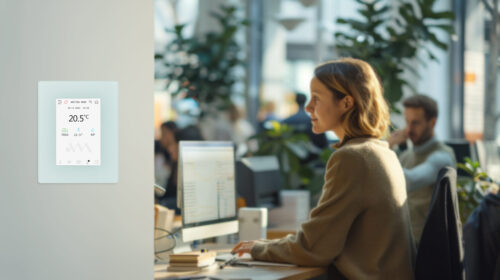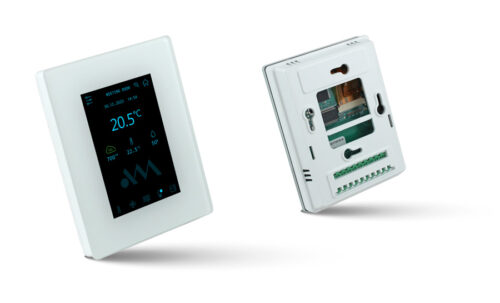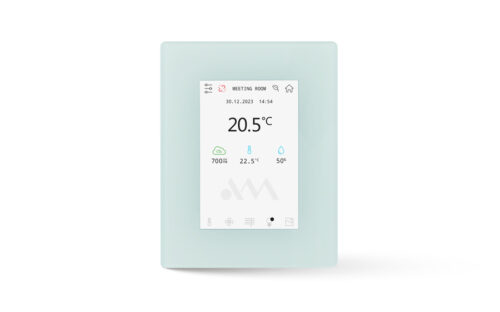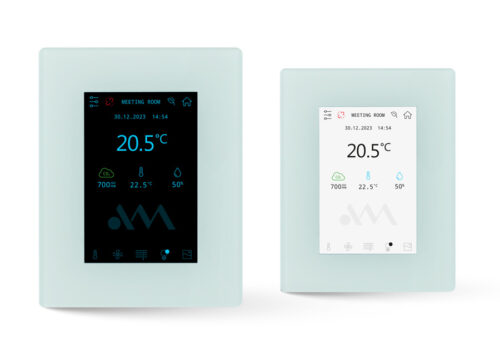One device, multiple functions – main objective for the AMR-OP75RHR unit
After a while, AMiT Automation is now offering a new on-wall controller that differs from the others in many ways. At first glance, the design is unmistakable – the all-glass front with a high-quality, high-resolution colour touchscreen. On the other hand, once installed, it does not draw attention to itself and does not interfere with the room’s interior. Although it is still a peripheral for control systems, the scope of application is much wider. It provides the user with intuitive and comfortable control of all the basic functions of a modern, fully automated room – temperature, ventilation, lighting and shading control. That is why we refer to this controller more as a room operating unit.
The AMR-OP75RHR can be mounted on a smooth wall or in a KU 68 mounting box. The communication interface to the control system is provided by RS485 interface with MODBUS RTU protocol support. Power supply is standard 24 V DC. The easy-to-read colour display with capacitive touch screen has a resolution of 320×480 pixels with a display area of 49×73 mm. The backlight of the display can be user-adjustable or use the ambient backlight control function to adjust the backlight to the ambient light conditions. The unit consists of two parts – a front panel with display and electronics and a mounting tray with terminal block. This proven concept is especially appreciated during installation, as the cabling can be realised at the time of finishing construction work without damaging the unit. The electronics display can be mounted very easily when commissioning the automation technology. In addition, the electronics display can be attached to the mounting tray with a locking screw, preventing unwary hands from quickly dismantling the unit.
The AMR-OP75RHR unit is available in white, we are also preparing a black variant. The unit primarily measures room temperature, relative humidity, has an input for an external RTD/NTC temperature sensor and a switching relay can be used as an output. Additionally, the AMR-OP75RHRC variant can also measure the CO2 concentration in the room and signal its exceedance not only graphically but also audibly.
As mentioned, the unit is essentially a peripheral of the control systems and provides the user’s interface with the controlled technologies. It can thus replace many different controllers and switches that are common in rooms today: thermostat for temperature control, controller for air conditioning, switches for light circuits and various switches for controlling blinds. Often the implementation of “smart” rooms looks like this.
The AMR-OP75RHR(C) room control unit combines all these control peripherals into a single device.
For the unit to meet this goal, it was necessary to design a user-friendly control that was intuitive and easy to use without complicated manuals and instructions. That’s why we have equipped the unit with a standard application that is easy to configure and covers most of the requirements for controlling technology in offices, hotels, hospitals or residential units. The control screens for each technology have common controls so that the user does not have to search and search for what they can touch and what actually happens. Let’s introduce the basic control screens.
Setting the desired temperature in the room and controlling the ventilation (air conditioning) is functionally very similar to what our customers are familiar with in other on-wall controllers.
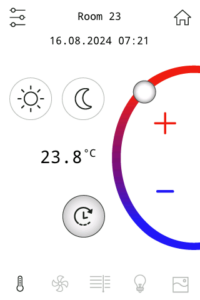
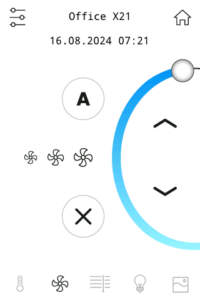
Lighting control supports control of multiple circuits. Each circuit can be individually controlled depending on whether only on/off mode or dimming or chromaticity control is required.
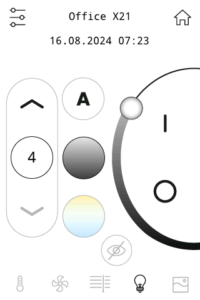
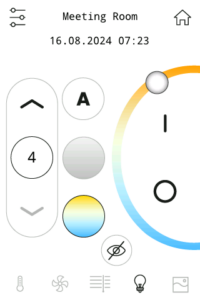
Similarly for shading controls – depending on the different types of shading technology, a simple “two-button” or continuous control can be used, including tilting of the slats for shutter variants.
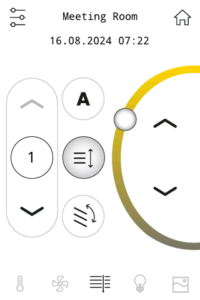
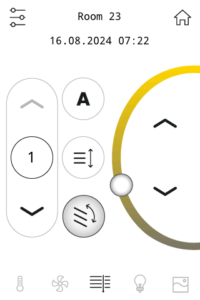
The individual light and shade circuits can be individually named for better clarity during use. If the master control system offers the user room automation according to pre-set scenes, the AMR-OP75RHR(C) can also offer elegant selection of the desired scene.

The user can get comprehensive information about the state of the controlled room on the so-called Home screen, where the current temperature, humidity in the room and, in the version with CO2 measurement, the current concentration can be quickly checked. In this case, the user can configure whether the unit should not only indicate when an elevated CO2 concentration limit is exceeded in colour on the display, but also whether an audible indication should be activated. Other information can also be displayed on the Home screen – e.g. the room name, current date and time or current outside temperature. At the same time, the bottom section shows which functions can be controlled by the unit in the room.

The user can customise the unit to make it as comfortable as possible and to his or her exact preferences. Basic user options include language selection, brightness setting (including adaptive ambient control), how to use the saver, audible indication of CO2 limits exceeded, display of measurement limits, and/or display mode (dark/light mode).
For the service technician, the possibilities for specific unit settings are much greater. In the system menu, he can specify which control functions the unit will support, what specific type of lighting and shading circuits are, the modes of displaying the Home screen, the unit’s communication parameters, the setting of the access password, etc. To facilitate configuration, we recommend using the AppConfig configuration program, which makes setup a breeze and, most importantly, allows the configuration of units to be reused on already installed units in the RS485 network.
From the above description, it is clear that we are bringing a new type of control system unit to the market that will cover a wide range of requirements in fully automated rooms. We believe that the AMR-OP75RHR(C) room operating unit, in cooperation with AMiT Automation control systems, will contribute to improving the quality of the indoor environment in buildings where, unfortunately, we spend more and more time.

